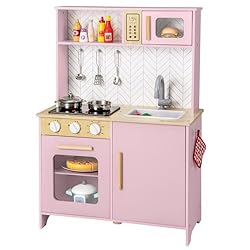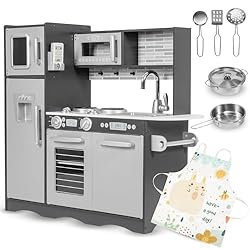The Perfect Recipe for Fun: Why Play Kitchens Make Amazing Gifts 🍳
Few gifts capture the imagination quite like a play kitchen. These delightful mini cooking stations offer more than just pretend play—they open the door to a world of creativity, collaboration, and learning. Whether you're shopping for a budding chef, a curious toddler, or simply looking for a present that promises hours of entertainment, a play kitchen is a fantastic choice.
What makes these toy kitchens so appealing is their versatility. They're not just about flipping imaginary pancakes or making pretend tea; they encourage problem-solving, social skills, and even the early development of an interest in food and cooking. It's a gift that grows with the recipient, allowing for new ways to play and explore as they get older.
Play kitchens are available in a variety of designs, from sleek modern setups to charming retro styles, making it easy to find one that suits any personality or space. They also range in features, with some offering light-up hobs, realistic sounds, or even mini fridges and ovens. Pair it with a few accessories like pretend food or toy utensils, and you've got a complete gift that will light up their face on the big day.
If you're searching for a gift that combines creativity, practicality, and endless fun, a play kitchen might just be the perfect pick. It’s more than a toy—it’s an invitation to explore, imagine, and share countless pretend meals with friends and family.
A Buyer’s Guide to Choosing the Right Play Kitchen
Material Matters: Wooden vs Plastic Play Kitchens
When choosing a play kitchen, the material is one of the most important factors to consider:
-
Wooden Play Kitchens
- Durable and long-lasting, making them great for younger children.
- Often feature a more natural and classic aesthetic.
- Eco-friendly options are widely available.
-
Plastic Play Kitchens
- Lightweight and easier to move around.
- Typically more affordable and come in vibrant colours.
- Often include more interactive features like sounds and lights.
Consider the recipient’s play style and the environment when deciding between the two.
Size Does Matter: Finding the Perfect Fit
Play kitchens come in a range of sizes, so think about where it will live:
- Compact kitchens are ideal for smaller spaces or flats.
- Larger kitchens with multiple stations are perfect for shared play.
- Portable options with foldable designs make tidying up a breeze.
Be sure to measure the available space and check product dimensions to avoid surprises.
Features to Look For: Beyond Pots and Pans
Modern play kitchens go beyond basic setups. Keep an eye out for:
- Interactive Elements: Light-up hobs, sound effects, or pretend water dispensers.
- Storage Solutions: Built-in cupboards or shelves to keep accessories tidy.
- Extra Stations: Features like microwaves, fridges, or dishwashers for extended play.
These details can make the play kitchen even more engaging and realistic.
Accessories That Complete the Package
The right accessories can elevate a play kitchen into a full culinary experience:
- Sets of pretend food, from fruits and veggies to cupcakes and pizzas.
- Toy utensils like spatulas, whisks, and mixing bowls.
- Aprons and chef hats to add a touch of role-play.
Opt for accessories that match the age and interests of the recipient.
Safety First: What Every Buyer Needs to Know
Safety is always a top priority when purchasing a gift for children:
- Ensure the kitchen is made from non-toxic materials.
- Look for sturdy designs that won’t tip over during play.
- Rounded edges and child-safe hinges can prevent accidental injuries.
Always review product specifications to ensure they meet safety standards.
FAQs About Play Kitchens
What Age Group Are Play Kitchens Suitable For?
Play kitchens are versatile and can suit various age ranges:
- Toddlers (1–3 years): Look for simple setups with large, easy-to-grab pieces.
- Preschoolers (3–5 years): Opt for kitchens with more features and accessories.
- Older Kids (5+ years): Interactive kitchens with advanced elements like sounds and lights are ideal.
The best part? These toys often grow with the child, offering years of entertainment.
Are Play Kitchens Gender-Neutral Toys?
Absolutely! Play kitchens are perfect for kids of any gender. They encourage creativity, role-playing, and essential life skills, making them a timeless, universal gift.
How Easy Is Assembly?
Assembly times can vary:
- Simple plastic kitchens are often quick to set up.
- Larger wooden kitchens may require more time and tools.
Many play kitchens come with clear instructions, but enlisting an extra pair of hands can make the process smoother.
Do Play Kitchens Encourage Real-Life Skills?
Yes! Play kitchens foster:
- Creativity: Designing pretend meals and experimenting with "recipes".
- Social Skills: Encouraging cooperative play with friends or siblings.
- Motor Skills: Opening doors, turning knobs, and handling small accessories.
They also introduce concepts like organisation and tidiness in a fun way.
How Much Space Do I Need for a Play Kitchen?
The space needed depends on the model you choose:
- Smaller kitchens can fit into corners or under tables when not in use.
- Larger models may require a dedicated play area.
Make sure there's enough room for children to move around and access all parts of the kitchen.
Beyond the Basics: Tips and Ideas for Gifting a Play Kitchen
Personalising the Experience
Add a personal touch to make the gift truly special:
- Customise the kitchen with decals or their name.
- Choose accessories that reflect their favourite foods or activities.
- Consider themes like a café, bakery, or diner for an extra layer of fun.
Pairing Gifts for Maximum Fun
Enhance the gift by pairing it with complementary items:
- A cookbook for kids filled with simple recipes.
- Mini shopping baskets or tills for a grocery shopping role-play experience.
- A set of pretend cleaning tools to teach responsibility in a playful way.
Setting the Scene: Creating a Mini Kitchen Space
Transform a corner of their room into a full play zone:
- Add a small table and chairs for pretend dining.
- Include a wall-mounted chalkboard for menus and recipes.
- Use colourful storage bins to keep everything organised and accessible.
Eco-Friendly Play Kitchens: A Sustainable Option
For environmentally conscious buyers, look for:
- Kitchens made from sustainable materials like bamboo or FSC-certified wood.
- Brands that use recycled packaging.
- Accessories crafted from natural materials or fabric instead of plastic.
Sustainable options can teach kids about eco-friendly living from an early age.
The Role of Play Kitchens in Learning
Play kitchens are more than just fun—they’re educational too:
- Math Skills: Counting ingredients or measuring pretend portions.
- Language Development: Naming foods and describing their pretend meals.
- Imaginative Play: Acting out roles, from head chef to café owner.
These experiences can contribute to important developmental milestones.
Alternative Gift Ideas for Mini Chefs
If a play kitchen isn’t quite right, consider these alternatives:
- Baking Kits: Hands-on fun with simple, kid-friendly recipes.
- Toy Food Trucks: Portable and full of unique play opportunities.
- Themed Books: Stories about cooking or running a restaurant.
- Craft Kits: Activities like making pretend food out of clay or felt.
Each of these options can complement or replace a play kitchen, depending on the recipient's interests.
Unboxing the Joy: Wrapping Up Your Play Kitchen Gift Ideas 🎁
Play kitchens offer a unique blend of creativity, education, and entertainment. They inspire children to explore, imagine, and develop real-world skills, all while having a fantastic time. Whether you choose a small, portable option or a fully interactive masterpiece, this gift is sure to deliver endless smiles and unforgettable moments. For any child who dreams of cooking up adventures, a play kitchen is more than a toy—it’s the gift of imagination in action.



















